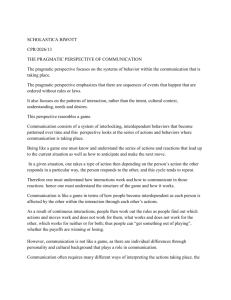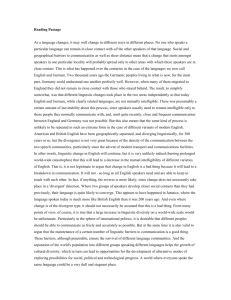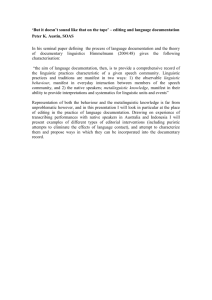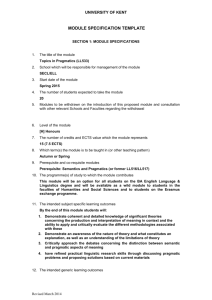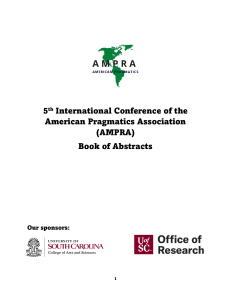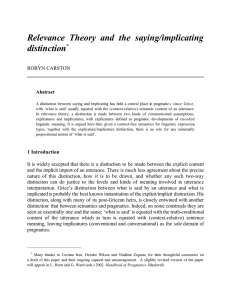syllabus.pragmatics - Cognitive, Linguistic & Psychological
advertisement
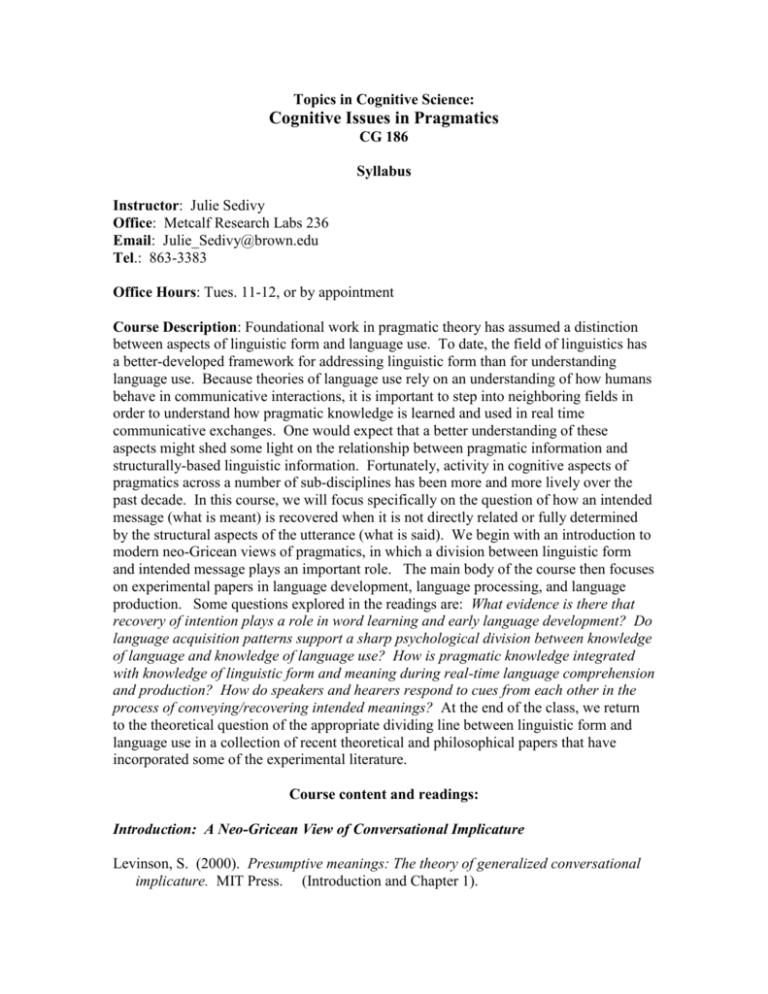
Topics in Cognitive Science: Cognitive Issues in Pragmatics CG 186 Syllabus Instructor: Julie Sedivy Office: Metcalf Research Labs 236 Email: Julie_Sedivy@brown.edu Tel.: 863-3383 Office Hours: Tues. 11-12, or by appointment Course Description: Foundational work in pragmatic theory has assumed a distinction between aspects of linguistic form and language use. To date, the field of linguistics has a better-developed framework for addressing linguistic form than for understanding language use. Because theories of language use rely on an understanding of how humans behave in communicative interactions, it is important to step into neighboring fields in order to understand how pragmatic knowledge is learned and used in real time communicative exchanges. One would expect that a better understanding of these aspects might shed some light on the relationship between pragmatic information and structurally-based linguistic information. Fortunately, activity in cognitive aspects of pragmatics across a number of sub-disciplines has been more and more lively over the past decade. In this course, we will focus specifically on the question of how an intended message (what is meant) is recovered when it is not directly related or fully determined by the structural aspects of the utterance (what is said). We begin with an introduction to modern neo-Gricean views of pragmatics, in which a division between linguistic form and intended message plays an important role. The main body of the course then focuses on experimental papers in language development, language processing, and language production. Some questions explored in the readings are: What evidence is there that recovery of intention plays a role in word learning and early language development? Do language acquisition patterns support a sharp psychological division between knowledge of language and knowledge of language use? How is pragmatic knowledge integrated with knowledge of linguistic form and meaning during real-time language comprehension and production? How do speakers and hearers respond to cues from each other in the process of conveying/recovering intended meanings? At the end of the class, we return to the theoretical question of the appropriate dividing line between linguistic form and language use in a collection of recent theoretical and philosophical papers that have incorporated some of the experimental literature. Course content and readings: Introduction: A Neo-Gricean View of Conversational Implicature Levinson, S. (2000). Presumptive meanings: The theory of generalized conversational implicature. MIT Press. (Introduction and Chapter 1). Early word learning and discerning communicative intent Bloom, P. (2002). Mindreading, communication and the learning of names for things. Mind & Language, 17, 37-54. Diesendruck, G., & Markson, L. (2001). Children’s avoidance of lexical overlap: A pragmatic account. Developmental Psychology, 37, 630-641. Samuelson, L., & Smith, L. (1998). Memory and attention make smart word learning: An alternative account of Akhtar, Carpenter and Tomasello. Child Development, 69, 94-104. Diesendruck G, Markson L, Akhtar N, & Reudor A. (2004). Two-year-olds' sensitivity to speakers' intent: an alternative account of Samuelson and Smith. Developmental Science, 7, 33-41. Kaminski J, Call J, & Fischer J. (2004). Word learning in a domestic dog: Evidence for "fast mapping". Science, 304, 1682-1683. Bloom, P. (2004). Can a dog learn a word? Science, 304, 1605-1606. Markman, E.M., & Abeley, M. (2004). Word learning in dogs? Trends in Cognitive Sciences, 8, 479-481. Happe, F., & Loth, E. (2002). “Theory of mind” and tracking speakers’ intentions. Mind & Language, 17, 24-36. Mintz, T.H. (2005). Linguistic and conceptual influences on adjective acquisition in 24and 36-month-olds. Developmental Psychology, 41, 17-29. Akhtar, N. (2002). Relevance and early word learning. Journal of Child Language, 29, 677-686. Papafragou, A. (2002). Mindreading and verbal communication. Mind & Language, 17, 55-67. Pragmatic inference and later language acquisition Noveck, I. (2001). When children are more logical than adults: Experimental investigations of scalar implicature. Cognition, 78, 165-188. Papafragou, A., & Musolino, J. (2003). Scalar implicatures: Experiments at the semantics-pragmatic interface. Cognition, 86, 253-282. Feeney, A., Scrafton, S., Duckworth, A., & S. Handley. (2004). The story of some: Everyday pragmatic inference by children and adults. Canadian Journal of Experimental Psychology, 58 (2), 121-132. Ryder, N. (2003). Use of Context in Question Answering by 3-, 4-, and 5-Year-Old Children. Journal of Psycholinguistic Research, 32, 397-415. Jackson, S. (1981). Conversational Implicature in Children's Comprehension of Reference. Communication Monographs, 48, 237-249. Real-time inference processing by hearers Bott, L., & Noveck, I.A. (2004). Some utterances are underinformative: The onset and time course of scalar inferences. Journal of Memory and Language, 51, 437-457. Noveck, I.A., & Posada, A. (2003). Characterizing the time course of an implicature: An evoked potentials study. Brain and Language, 85, 203-210. Hamblin, J.L., & Gibbs, R. W. : Processing the meanings of what speakers say and implicate. Discourse Processes, 35, 59-80. Sedivy, J. (2003). Pragmatic versus form-based accounts of referential contrast: Evidence for effects of informativity expectations. Journal of Psycholinguistic Research. 32(1), 3-23. Grodner, D. & Sedivy, J. (In press) The effects of speaker-specific information on pragmatic inferences. In N. Pearlmutter & E. Gibson (eds). The Processing and Acquisition of Reference. MIT Press: Cambridge, MA. Real-time production processes in the speaker, and adjustments to the hearer Brown, P.M., & Dell, G.S. (1987). Adapting production to comprehension: the explicit mention of instruments. Cognitive Psychology, 19, 441-472. Lockridge, C.B., & Brennan, S.E. (2002). Addressees' needs influence speakers' early syntactic choices. Psychonomic Bulletin & Review, 9, 550-557. Horton, W.S., & Keysar, B. (1996). When do speakers take into account common ground? Cognition, 59, 91-117. Horton, W.S., & Gerrig, R. (2002). Speakers’ experiences and audience design. Journal of Memory and Language, 47, 589-606. Horton, W.S., & Gerrig, R. (2005). The impact of memory demands on audience design during language production. Cognition, 96, 127-142. Speaker-hearer coordination during communication Brennan, S.E. & Clark, H.H. (1996). Conceptual pacts and lexical choice in conversation. Journal of Experimental Psychology: Learning, Memory and Cognition, 22, 1482-1493. Metzing, C., & Brennan, S.E. (2003). When conceptual pacts are broken: Partnerspecific effects on the comprehension of referring expressions. Journal of Memory and Language, 49, 201-213. Hanna, J.E., & Tanenhaus, M.K. (2004). Pragmatic effects on reference resolution in a collaborative task: evidence from eye movements. Cognitive Science, 28, 105-115. Theoretical/ philosophical issues Bontly, T.D. (2005). Modified Occam's Razor: Parsimony, pragmatics, and the acquisition of word meaning. Mind & Language, 20, 288-312. Recanati, F. Does linguistic communication rest on reference? Mind & Language, 17, 105-126. Saul, J. (2002). What is said and psychological reality: Grice’s project and relevance theorists’ criticisms. Linguistics and Philosophy, 25, 347-372. Stone, M. (2004). Intention, interpretation and the computational structure of language. Cognitive Science, 28, 781-809. Horn, L. (2005). "The Border Wars." In K. Turner & K. von Heusinger (eds.), Where Semantics Meets Pragmatics. Elsevier, 2005. Course Requirements: In-class participation and discussion syntheses Final paper 60% 40% Everyone is expected to have done a careful reading of the papers for the each class, and to contribute to the discussion. After each class, one of you will be charged with writing and circulating a summary synthesis of the discussion of the readings that arose during class. These summaries (and hence class discussions) should identify links between the readings and previous papers, outstanding questions or problems with the papers, alternative interpretations of data, ideas for further extensions of the work etc. The final paper should outline a research project proposal intended to address some unresolved question in the literature we have covered.
